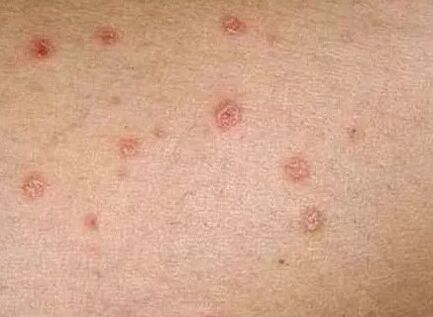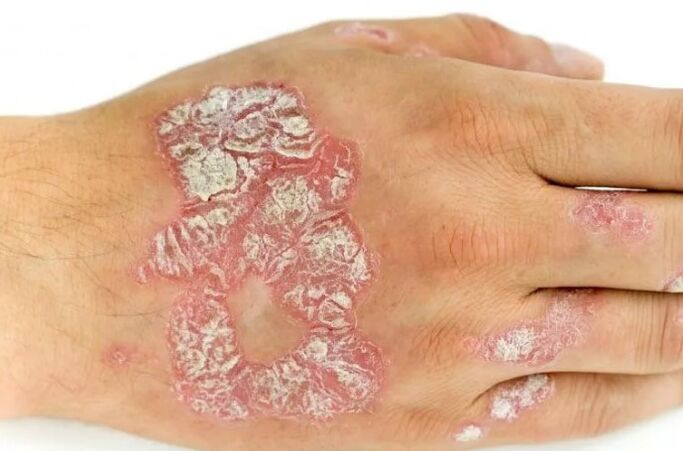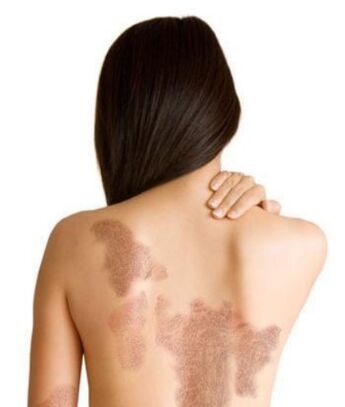Despite the unknown etiology of psoriasis and the factors that provoke it, the stages of its development have been well studied.The classification of stage psoriasis facilitates the evaluation of the course of the disease, helps identify the sensitivity to a particular method of treatment and the determination of patients' tactics.

The stages of psoriasis are classified depending on the nature of the irritation (or activity of the inflammation process) and severity.
Stages of psoriasis depending on the irritation
Psoriasis is a disease that has 3 stages:
- Progressive;
- stationary;
- Retrogressive;
- PARDON
The symptoms of the progressive phase
This stage is characterized by visible signs of irritation.Numerous rash appears on the skin, having the shape of red joints (papules, tubercles) that have an oval or rounded shape.They unite and form seals that occupy a large area, their surface is actively peeled, the patient at the same time experiences severe itching of the skin, and sometimes a burning sensation.Itching can be exhausting and disturbing the patient, not only during the usual life, but also in a dream, itching to intensify when contacting clothes.After delaying the scales, the surface can be wet and transformed into a nutrient medium for the spread of bacteria.
The main manifestations of the progressive phase are:
- the appearance of the papule on the extensor surfaces of the limbs and in the body;
- joining the papules into the conglomerate ("tiles"), which has a white color;
- peeling the surface of the conglomerate;
- There is no staircase in the region of the edges of the tiles, but there is a hyperemic edge;
- The edges of the tiles are compressed;
- The presence of a kebner phenomenon: When mechanical damage (cut, scratch) appears on uninhabited skin, a new psoriatic plaque is formed in its place.
The more intense during the progressive phase the rash is, the more active the process of inflammation.The most dangerous consequence of psoriasis is psoriatic arthritis, while severe articular pain occurs, as a result, the joints are deformed.

Symptoms of stationary phase
With the onset of the stationary phase, a gradual weakening of the irritation process occurs.At the same time, the papules turn pale, they turn from red to rose, new rashes in this period do not appear.The surface of the joints has the shape of "tiles", is dense, covered with a crust, which is represented by multiple scales of dried skin.The nature of the papule healing begins from the center to the suburbs.The presence of a stationary phase of psoriasis confirms the effectiveness of treatment.
The main manifestations of this phase are:
- lack of new papule rashes;
- Existing tiles stop their growth;
- The surface of the tiles is covered with scales;
- The red rim disappears around the burning plates;
- Kebner's phenomenon disappears.
Symptoms of the regression phase
At the regression phase, the process is inclusion.The "tiles" are selected, forming areas of skin depigmentation.Itching the skin gradually disappears, signs of peeling.
Signs of psoriasis regression:
- There is an edge of Voronov around the plates (visible dense ring folds, located around psoriatic plates);
- gradual landing and disappearance of peel;
- At the site of the tiles, depigmentation areas (white or dark) are formed.
In the regression phase, the tiles disappear completely, the remnants of the plates are possible in the area: knees, elbows, abdomen, buttocks.
forgiveness
Remission is the stage of apparent recovery.During forgiveness, psoriasis is in a "sleep" state but does not disappear from the body.Psoriasis remizion lasts until other irritation (progressive phase).

It should be noted that during the irritation of psoriasis, a person's overall condition does not change, he goes to work, is engaged in known household issues.Psoriasis only brings an aesthetic and cosmetic defect for a person: the patient's skin scratches too much, a person cannot wear open clothes, if an irritation during the summer, a person cannot visit the pool, go to massage, cosmetic procedures, etc.
Stages of psoriasis depending on the lesion area
The severity of psoriasis also depends on the area of skin lesions.So, at a small stage, only 3%of the skin surface is affected, with an average - from 3 to 10%, and with one heavy - more than 10%.Psoriasis, which caused damage to the joints, belongs to a severe degree, in this case the area of skin lesions is not taken into account.You can measure the damage area yourself.For this purpose, the open palm rule is used (the skin area corresponding to the area of the human palm is 1% of the entire surface of the body).
Index after
The general system for evaluating the severity of psoriasis is evaluated using the index because, which involves an estimate of prevalence and severity, as well as the severity of the manifestation of the disease.This indicator is estimated from 0 to 72. At the same time, the mild rate of psoriasis has a less than 10 indicator, average - from 10 to 20, more than 20. Using the index as the clinical effectiveness of treatment is also calculated.
In addition to different stages, psoriasis can have different types: seborrheic, exudative, plantar, interigal, Old, rupioioid, halted, psoriasis of nails and mucous membranes.It is impossible to fully cure psoriasis, but you can achieve a long apology.This purpose is followed by modern treatment methods.























